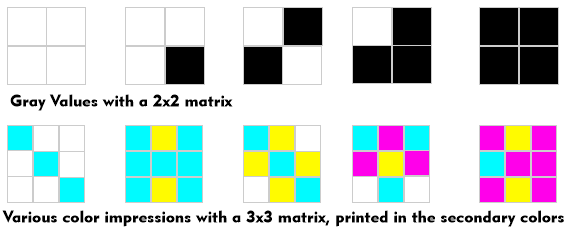dithering
- Dithering is a display technique in which brightness and color impression are emulated by raster techniques. The dithering technique, used in color printers and in displays with TN technology with Frame Rate Control( FRC), takes advantage of the limited resolution of the human eye, which integrates individual, closely spaced brightness or color points into an average value. In dithering, the continuous color impression is created by dividing a gray or color value into a small grid of pixels. The finer the raster, the more detailed the color differences. If such a raster consists of 2 x 2 pixels, then five different brightness levels can be printed; with a 3 x 3 matrix, there are ten. If three pixels are printed in cyan and three in magenta in such a 3x3 matrix, the eye integrates this color mixture to form the color impression blue. In this subtractive color mixing process, the size of the dots produced by the printer always remains the same. It is different with the halftone process. The color palette that can be reproduced depends on the color mixing and the color model used, with color printers working with the CMYK color model. The same applies to black and white representations, where the gray scale is achieved by a lower or higher number of black pixels.
- In video technology, dithering is a process which, similar to printing technology, enables a fine color mixture of image parts from a limited supply of values by a locally and temporally distributed mixture of color points of the limited supply ( e.g. 6 bits). A disadvantage results from the limited resolution of the image and, in the case of temporal dithering, from the occurrence of color noise. With a sufficiently large viewing distance (resolution limit of the eye), however, these effects do not appear.
- The term dithering is also used in acoustics. It is a noise-shaping process used to reduce quantization errors during the digitization of audio signals. Technically, the least significant bits( LSB) of the digitized audio signal are changed at a high frequency, creating a noise effect. The signal used for dithering is a triangular signal or it has a Gaussiandistribution.

